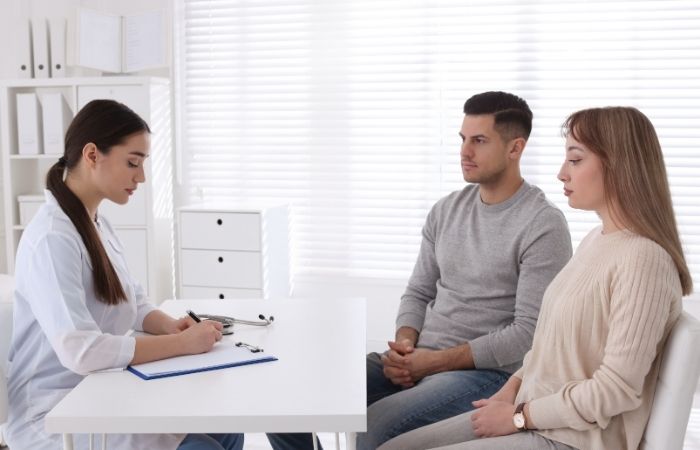STD Prevention for Queer Women; Yes, It Matters
Quick Answer Box
Chlamydia often causes no symptoms, but when it does, the signs are different for men and women. Men may experience burning while urinating or discharge from the penis, while women might notice unusual vaginal discharge, bleeding after sex, or pelvic pain. The only way to know for sure is to get tested.
The Infection That Doesn’t Announce Itself
You don’t always know when Chlamydia has moved in. That’s part of what makes it so dangerous, and so easy to spread. This bacterial infection passes through vaginal, anal, or oral sex, but it doesn’t always throw up a red flag. In fact, most people, especially women, don’t notice a single symptom.
Roughly half of men and nearly three-quarters of women infected with Chlamydia experience no obvious signs at all. If anything does feel off, it’s often subtle. Maybe a slight burn when you pee, or a change in discharge that could be mistaken for a yeast infection. Maybe a weird cramp that feels like period pain. Maybe nothing at all. That’s how it hides, by mimicking things you’ve felt before and brushing it off as no big deal.
But while it plays nice on the surface, underneath it can be doing real damage. Left untreated, Chlamydia can lead to pelvic inflammatory disease, scarring, infertility, and long-term pelvic pain. It can also quietly pass to partner after partner. That’s the trap: it’s silent until it’s not.

People are also asking: What happens if chlamydia is left untreated?
What It Looks Like in a Woman’s Body
In people with a uterus, Chlamydia usually starts by infecting the cervix, the gateway between the vagina and the uterus. From there, it can spread upwards without making a sound. But if symptoms do appear, they often come as subtle changes: a watery or yellowish vaginal discharge, a burning feeling during urination that might mimic a UTI, or bleeding after sex that feels random and confusing.
Sometimes the signs feel more physical, like a dull ache in the lower belly, or sharp cramping during or after intercourse. But even those can be brushed off as stress, ovulation, or an off-cycle period. That’s what makes Chlamydia so dangerous in women: it rarely screams. It whispers. And if it’s ignored, it can lead to Pelvic Inflammatory Disease (PID), which causes scarring in the fallopian tubes, chronic pain, and even infertility.
It’s not just reproductive risk, either. Chlamydia can increase your vulnerability to other infections, including HIV. That’s why it’s not just about discomfort, it’s about long-term health. And if your symptoms are light, or completely absent, it doesn’t mean the infection isn’t progressing.
How Chlamydia Shows Up in Men
For men, Chlamydia usually takes hold in the urethra, the tube that carries urine and semen out of the body. When symptoms do show up, they tend to come sooner, often within a few weeks of exposure, but they’re still easy to ignore or misread.
The most common signs include a slight discharge from the tip of the penis, often clear or cloudy, and a burning or stinging feeling when urinating. Some men report itching or discomfort at the opening of the penis. In fewer cases, there’s pain or swelling in the testicles, which can signal a complication called epididymitis, an inflammation of the tube that carries sperm.
But just like in women, many men feel nothing at all. No discharge. No pain. Just life as usual, until a partner tests positive, or fertility issues appear months or years later. And during that time, the infection keeps spreading.
This asymptomatic window is one of the reasons Chlamydia travels so fast among heterosexual and queer populations alike. Without clear symptoms, it doesn’t feel urgent. But the risks are still there, and they don’t care if you felt sick or not.
Order Now $189.00 $490.00 Check Your STD Status in Minutes
Test at Home with Remedium
10-in-1 STD Test Kit




For all 10 tests
Beyond the Genitals: Where Else Chlamydia Hides
Think Chlamydia only affects the genitals? Not quite. This infection isn’t picky about where it lands. It can live in your throat, rectum, and even your eyes, depending on how and where you’ve had contact.
Oral sex can expose the throat to Chlamydia, although symptoms are rare. If they do show up, it might feel like a mild sore throat or a lingering tickle. Nothing major, just enough to be mistaken for allergies or a cold. That makes throat infections a hidden threat, especially since you can still pass it on without knowing you’re infected.
Anal sex introduces another risk. In people who engage in receptive anal sex, Chlamydia can infect the rectum and cause symptoms like rectal pain, discharge, or bleeding. Some report a constant feeling of needing to have a bowel movement. Others feel nothing at all.
Chlamydia can also cause eye infections if it comes into contact with your hands or fluids during sex. This form can lead to redness, swelling, and discharge, looking a lot like pink eye.
If you’ve had multiple types of contact, oral, anal, vaginal, you might be infected in more than one place. And while most routine tests only check the genitals or urine, at-home tests like this one can be targeted based on your exposure:
The Unseen Damage: Why Women Face Higher Risks
There’s no nice way to put this: Chlamydia is more dangerous to people with uteruses. Not because the bacteria are crueler, but because the anatomy gives the infection more places to quietly wreak havoc.
When untreated, Chlamydia can climb up the reproductive tract, inflaming the uterus and fallopian tubes. This can lead to Pelvic Inflammatory Disease (PID), a serious, often permanent condition that causes scarring, chronic pelvic pain, and blocks the tubes that allow eggs to travel. The result? Many women only learn they ever had Chlamydia when they’re struggling to conceive.
It doesn’t stop there. If the infection reaches the uterus during pregnancy, it can lead to premature birth, low birth weight, or even be passed to the baby during delivery, potentially causing pneumonia or eye infections in newborns.
Men can experience complications too, like epididymitis, which causes swelling and pain in the testicles and can also affect fertility. But statistically, the risks of long-term reproductive damage hit women harder and faster. And because symptoms are often invisible, the clock starts ticking long before anyone thinks to get tested.

People are also asking: Can chlamydia go away without antibiotics?
Treatment That Actually Works (But Only If You Know You Need It)
Here’s the part that should calm you down a bit: Chlamydia is completely curable. It’s one of the few STDs where a short course of antibiotics, usually azithromycin or doxycycline, can wipe it out entirely.
But treatment only works if you know you have it. That’s the catch.
Too many people delay testing because they’re embarrassed, or because they feel fine, or because they’re worried what a doctor will think. Some people convince themselves it’s just irritation from shaving or a new detergent. Others stay in relationships where testing is discouraged, shamed, or even threatened.
The truth? Getting tested doesn’t mean you’re dirty. It means you’re informed. And it gives you the power to treat the infection early, before it becomes something permanent. Most treatments are oral, discreet, and over in a week. You’ll be asked to abstain from sex during that time and get retested in a few months to make sure the infection is really gone.
At-home kits make it easier than ever to get answers without stepping into a clinic. Pee in a cup, swab your throat, mail it off. That’s it.
Real People, Real Symptoms: A Tale of Two Bodies
Tasha, 26, thought she had a yeast infection. There was some discharge and mild itching, but nothing alarming. She used over-the-counter meds and went on with life, until she started bleeding after sex. Her partner noticed. She freaked out. The clinic visit confirmed Chlamydia, and an ultrasound a few months later revealed scar tissue forming in her fallopian tubes. She’d had it for months without knowing.
Jordan, 30, felt a weird sting while peeing but chalked it up to dehydration or rough sex. It only lasted a day or two, so he ignored it. A year later, during routine testing with a new partner, he found out he was positive. The guilt hit him harder than the infection, he’d unknowingly exposed three previous partners.
Neither of them looked sick. Neither of them felt like something was wrong. But their bodies had been carrying a silent infection that was doing more than just hanging out.
These aren’t cautionary tales, they’re everyday realities. And they’re reminders that Chlamydia doesn’t look like a disaster movie. It often looks like nothing. Until it’s something.
Order Now $69.00 $147.00 Check Your STD Status in Minutes
Test at Home with Remedium
3-in-1 STD Test Kit




For all 3 tests
Still Taboo in 2025: Why No One Talks About This Enough
You’d think with all the progress we’ve made, Chlamydia wouldn’t still be a whispered word. But here we are.
For many people, STDs still carry a heavy layer of shame, especially Chlamydia, because of how “common” and “preventable” it’s supposed to be. There's a pressure to feel stupid if you get it, to hide it from partners, or to assume it only happens to people who are reckless or dirty.
That’s all trash.
Chlamydia happens to monogamous couples, to first-timers, to sex workers, to teens, to married folks, to people who used condoms and still got unlucky. It doesn’t care if you’re “clean,” careful, or cautious. It only cares about opportunity, and human bodies are very good at providing that.
So here’s your permission to stop feeling embarrassed. Get tested, get treated, and move on. The more we normalize that, the less power this silent infection has.

People are also asking: How do I know if my sore throat is chlamydia or just a cold?
A History of Silence: How Chlamydia Stayed Hidden for Centuries
Chlamydia isn’t new. It just wasn’t taken seriously for most of medical history. For centuries, sexually transmitted infections were lumped together under vague, euphemistic names like “the clap” or “venereal disease.” And because Chlamydia often causes no symptoms, it didn’t even make the radar until the 20th century.
It wasn’t until the 1970s that researchers confirmed Chlamydia trachomatis as a distinct bacterial pathogen, one responsible for a massive share of pelvic infections, infertility, and undiagnosed urethritis. Before that, many people, especially women, were told their symptoms were “in their head,” or blamed on hygiene, birth control, or promiscuity.
This medical blind spot had real consequences. Generations of women were silently sterilized by an untreated infection, and men were allowed to unknowingly spread it without judgment or intervention.
Today, we have better testing, faster treatment, and more knowledge than ever before. But stigma and silence still echo that old history. And the infection still spreads fastest in the shadows.
Where We're Headed: The Future of Chlamydia Testing and Treatment
There’s good news on the horizon. Researchers are actively developing Chlamydia vaccines, and while nothing is on the market yet, several trials are showing promising results. If successful, we could see preventative options in the next decade, especially for high-risk groups.
On the testing side, things are already evolving fast. At-home testing has exploded in availability and accuracy. Modern test kits can screen for Chlamydia, Gonorrhea, and other STDs with a single urine sample or swab. Results are often available in days, and there’s no need to step into a clinic if that’s a barrier for you.
More exciting still? Some studies are working on rapid-result home tests, similar to COVID or pregnancy tests. Imagine knowing within 20 minutes whether you have Chlamydia. We’re not quite there yet, but we’re closer than ever.
And as digital sex ed, telehealth, and at-home health kits grow, the chances of catching Chlamydia early, and treating it before damage sets in, are higher than they’ve ever been.
Check Your STD Status in Minutes
Test at Home with Remedium7-in-1 STD Test Kit

 For Men & Women
For Men & Women Results in Minutes
Results in Minutes No Lab Needed
No Lab Needed Private & Discreet
Private & DiscreetOrder Now $129.00 $343.00
For all 7 tests
FAQs
1. Can Chlamydia go away on its own?
No. It may temporarily seem to fade, but it doesn’t clear without antibiotics and can still cause long-term damage.
2. How long after exposure can I test for Chlamydia?
Most accurate results show up after 1–2 weeks, though some people test positive earlier.
3. Can I get Chlamydia from oral sex?
Yes. It can infect the throat, even if the giver has no symptoms.
4. What does Chlamydia discharge look like?
It’s usually thin, milky, or yellowish. It may smell slightly stronger than usual.
5. Does Chlamydia always cause symptoms?
No. Up to 75% of women and 50% of men experience no symptoms.
6. Can I have Chlamydia and not pass it on?
Yes, but it’s unlikely. The infection is very contagious, even without symptoms.
7. How long does it take for Chlamydia to cause damage?
Damage like PID can begin in weeks or months if untreated. Sometimes sooner.
8. Can you get reinfected after treatment?
Absolutely. Chlamydia offers no immunity, and many people get it more than once.
9. Do condoms fully protect against Chlamydia?
They significantly reduce the risk, but don’t offer 100% protection, especially if there’s genital contact before use.
10. What test do I need?
Urine tests or vaginal/cervical swabs are most common. You can order one here: Chlamydia Home Test Kit

People are also asking: What does rectal chlamydia feel like?
Bypass Shame. Get Tested.
Something feels off down there, but shame isn’t a symptom.
If you're second-guessing every tingle, itch, or text from a past hookup, it's time to stop spiraling and start knowing. Chlamydia is common, treatable, and often silent, but you're not. Your body deserves answers, not anxiety.
Order your discreet at-home Chlamydia test kit now and get clarity without the awkward clinic visit.
Sources
1. About Chlamydia – CDC (overview, symptoms in men and women, complications including infertility)
2. Chlamydia – NCBI / Clinical overview, prevalence, impact on fertility
What happens if chlamydia is untreated? – Medical News Today (complications and long-term risks)
Impact of Chlamydia trachomatis in the reproductive setting – PMC (focus on male fertility)
Chlamydia – Wikipedia (epidemiology, symptoms by sex, complications, infants)
Is Chlamydia Curable? – Verywell Health (treatment, reinfection, implications for pregnancy)










